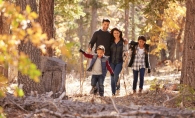
Bike camping, another way to say transporting yourself and your gear to and from your campsite entirely by bike, is in practice not a new thing at all—plenty of bike-touring aficionados have spent a day at a campsite through the years. But the practice seems to be having a resurgence, as families with children are adopting the habit.
As it turns out, the St. Croix Valley is prime for a first-time, sub-24 (24 hours or less) bike camping experience. With no fewer than seven state parks on both sides of the river, where camping is affordable and transport by bike means no vehicle permit needed, and an increasing series of trails and bike lanes throughout, perhaps you, too, will consider an outing this summer.
How to Plan
The first step is identifying a destination, which might require knowing your own mileage capabilities. For most starting out, a 20-mile ride, unloaded, is a good 2-hour-plus challenge. Adding a tent, or even a small bag of clothing and supplies, adds weight and potentially drag.
Then carefully plan a route. Program it into a GPS system or bike computer, but carry hard-copy maps, too. Look for bike-safe roads as much as possible: bike trails, bike lanes, low-traffic roads with wide shoulders. Consider driving or riding portions of the route in advance.
What to Pack
Bike and bags: Likely, you already have a bike, but do you have a bike that can take a rack or bags? Your local bike shop can help you out. That said, it can quickly become cost-prohibitive to add gear for what might be a one-time trip. Bob trailers or Burley-type kid-haulers might be a good way to carry not just your gear but your kids or pets (but be sure any trailer is certified for hauling live cargo before you do so).
Ultra-light: If you are considering new gear, the concept of ultra-light tents or even hammocks and bivvies (bottomless tent shelters) are ideal. If you can, a tarp is handy and multi-use. Basic camping supplies apply as well, but with everything think: how can I make this lighter or smaller?
Consider travel sizes: When it comes to clothing, pack as light as possible—long-sleeve but not bulky material, short-sleeve, ideally zip-off pants-shorts; err on the side of warmth. Plan to wear your camp clothes multiple days; only pack one set of bike clothes (for the ride there and the ride back). Check the weather; a wind-breaker/rain jacket is often a nice-to-have, if you have space. For toiletries, including bug spray and sunscreen, go with the smallest 3 oz.-type bottles you can get away with.
Food and drink: This is where things can get heavy quickly. There are lightweight burners that can boil water, and this makes your options endless in the realm of dehydrated foods. Backpacking outlets such as 45 Degrees in Stillwater sell a variety of these, but even things as simple as soups and oatmeal are good options. Bring just one cup and a spork for each individual. Paper plates are another option, as they can be disposed of in a campfire. Beverages should be acquired closer to your site, unless you want to haul a cooler all over the place.
Where to Go
There are six state parks up and down the river: Interstate, Afton, Willow River, Kinnickinnic, William O’Brien and Lake Elmo Park Reserve. Private and public campsites that are not affiliated with the state park system also abound.









